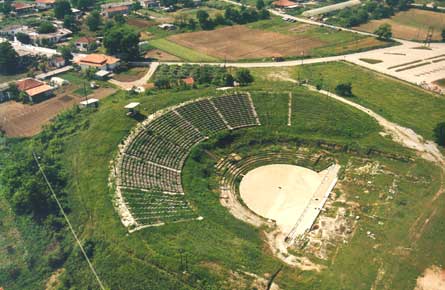
Macedonia, the kingdom of Alexander the Great is one of the most beautiful areas of Greece, rich in natural beauty, history, and archaeology and great food.In this thread we will see the 4 major archaelogical Sites that located in Macedonia.
One from the most important archaelogical found in Macedonia and more specific in Vergina was the Ivory Shield that was found in pieces in Philip's tomp.The arduous process of restoration took several years(14 years after a question to the quider).It is a unique masterpiece of the 4th century.
So we start with the Vergina.

ANCIENT VERGINA
Vergina (in Greek Βεργίνα) is a small town in northern Greece, located in the prefecture of Imathia, Central Macedonia. The town became internationally famous in 1977, when the Greek archaeologist Manolis Andronikos unearthed what he claimed was the burial site of the kings of Macedon, including the tomb of Philip II, father of Alexander the Great.
Vergina is about 13km south-east of the district centre of Veroia and about 80km south-west of Thessaloniki, the capital of Greek Macedonia. The town has a population of about two thousand people and stands on the foothills of Mount Pieria, at an elevation of 120m (360 ft) above sea level.
Founded by King Perdikas in the 7th Century BC it was formally known as Aigaes and was the first capital of Macedonia. When the capital was moved to Pella it was continued to be used as the royal burial grounds. In 336 BC, King Phillip II was assasinated by one of his seven bodyguards while attending the wedding of his daughter Cleopatra in the theatre.The Royal Palace was built for King Antigonas Gonatas, and while few of the walls that have been excavated stand very tall, the size of the area they cover is impressive. Archaeologists presume it was the summer residence of the king. The Royal Tomb has yielded great treasures, belonging to King Phillip, father of Alexander the great. All of these artifacts are in the archaeological museum in Thessaloniki which should be seen before visiting Vergina in order to get a more clear impression of what you are looking at. The tomb itself is still being excavated and is not open to the general public as of this writing. The Macedonian tomb with its facade of 4 marble columns, was a promising find when unearthed but unfortunately did not contain the vast treasures of the Royal tomb. It does contain an impressive marble throne or at least what is left of it.
ANCIENT DION

Dion is an area at the foot of Mt Olympus. Nowadays it is known all over the world because archaeologists discovered a very important Macedonian city. Ancient kings of Macedonia had chosen Dion as their summer resort. There they created, centuries ago, a settlement in the ruins of which the parts of the ancient Macedonian civilization are evident. Archaeologists, with Professor D Pantermalis at the head of them, discovered an admirable civilization. Remains of an ancient theatre, market baths and palace. The findings of graves found in Dion area are also remarkable. Most royal tombs give away the existence of an eminent and thriving civilization. Today we can admire the ruins of that civilization in the archaeological site of Dion and the archaeological museum of Dion.
Ancient Dion was an important religious center for worshipping the Gods of nearby Mount Olympus. This is where Phillip II came to celebrate his victories and his son Alexander came to make his sacrifices here before going off to conquer the East. While most of the statues which were not only found virtually intact, but with traces of color, are in the nearby museum in the town of Dion, they have been replaced with copies. The Sanctuary of Isis is perhaps the most interesting discovery so far. An earthquake had displaced water and mud and the building was hidden for centuries under 6 feet of water which protected it from vandals. The temple still sits in the water and a copy of the statue of Aphrodite can be seen there.
ANCIENT PELLA

Pella (Greek: Πέλλα) was the capital of the ancient kingdom of Macedon. A common folk etymology is traditionally given for the name Pella ascribing it to a form akin to Doric Greek Apella, originally to have meant a ceremonial location where decisions were made.However, the local form of Greek was not Doric, and the word exactly matches standard Greek pélla "stone", undoubtedly referring to a famous landmark from the time of its foundation.
The Capital of Macedonia moved from Vergina to Pella in the 5th Century BC and was in effect the capital of Greece. Many people come here to see the exceptional mosaics discovered in the remains of houses and public buildings. The museum is one of Greece's best on-site archaeology museums with a display of pottery, jewelry and mosaics found at the site. The remains of the buildings have impressed archaeologists and led them to believe that the Macedonians enjoyed a high level of wealth.
ANCIENT FILIPI
ANCIENT FILIPI

Site of the famous battle where the armies of Mark Antony and Octavius met and defeated the armies of Julius Ceasars assassins in 42BC. Brutas and Cassius committed suicide and the victors spent a fortune on Philippi, granting it the staus of Roman Colony, providing us with the impressive ruins, and artifacts which are now in the museum. In 49 AD Saint Paul came to preach to the inhabitants of Philippi and ended up in prison. Despite Paul's misfortune Phillipi was the first European city to accept Christianity, though the first two churches they built suffered some bad luck. The first was destroyed by an earthquake right after it was completed in the 5th century and the second collapsed before its dedication in the 6th Century because it was too top heavy.The remains can both be seen, as well as the ancient theatre built by Phillip II.




No comments:
Post a Comment